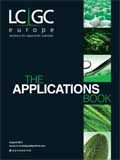The Determination of Organotins in Water Using Triple Quadrupole GC–MS–MS
The Application Notebook
Thermo Fisher Scientific Application Note
Introduction
The European Union Water Framework Directive seeks to lower detection and reporting limits for many contaminants (1). One class of these is organotins. Tributyltin compounds are considered the most hazardous, and several studies have shown the effect on shell malformation of oysters, imposex of marine snails and reduced resistance to infections (2,3).
The method described uses the Thermo Scientific TSQ Quantum XLS triple quadrupole GC–MS–MS system to provide detection and quantification limits that go below regulatory requirements with the use of timed selected reaction monitoring (t-SRM).
Sample Preparation
Derivatization and extraction of organotin compounds from water samples (4–6): From the water sample, 400 mL was taken and the pH was adjusted to 5 using a 1 M acetic acid/sodium acetate buffer prior to derivatization. For the ethylation of the organotin compounds, a 2% w/v sodium tetraethyl borate solution in 0.1 M NaOH was added. Extraction was performed by adding pentane, followed by shaking for at least ten minutes. The organic phase was transferred and slowly evaporated to 400 μL. A 3 μL injection was made on the GC.
Instrumentation
All sample analyses were carried out using the TSQ Quantum XLS GC–MS–MS system, equipped with a Thermo Scientific TRACE GC Ultra gas chromatograph. The TRACE GC Ultra was configured with a programmable temperature vaporizer (PTV) injector. The capillary column was a Thermo Scientific TraceGOLD TG-5MS column (5% phenyl film) of 30 m length, 0.25 mm inner diameter and 0.25 μm film thickness. An uncoated 2 m DMTPS deactivated 0.53 mm i.d. pre-column was used as a guard column.
EI-SRM Method Development
A higher-level standard was used for optimizing the transitions on the TSQ Quantum XLS GC–MS–MS operated in electron ionization (EI)-SRM mode. This function of t-SRM allows the instrument to monitor SRM transitions more efficiently by only monitoring at the specific elution times for the compounds analysed, allowing for partial overlap.
Results
A single-point calibration was used at a level of 10 ng/L. The concentration is calculated on the actual levels in the water sample, not in neat solutions. The results in Table 1 show the instrument's ability to reach 0.05 ng/L and below of organotins in the water sample, four times lower than the annual average stated in the Water Framework Directive. The actual amount injected on column was 0.2 pg for each organotin compound.

Table 1: Signal-to-noise ratio (S/N) for all of the organotins at 0.05 ng/L.
In SRM mode, at least two product ion transitions for each compound are needed, with peaks positively identified if the ion ratios in standards and samples are the same. The deviation for the calculated ion ratios must therefore be established by running their respective standards. The peaks were all easily detected at the lowest level and confirmed on two transitions.
Conclusion
This method demonstrates the ability of the TSQ Quantum XLS system to exceed the EU Water Framework Directive requirements for the detection and quantification of organotins (1,7). The t-SRM functionality gives the instrument the ability to automatically determine optimal SRM transition times, even allowing for partially overlapping SRM transitions. This method demonstrates detection and quantification levels to 0.05 ng/L, exceeding the EU Directive's Annual Allowable average of 0.2 ng/L.
References
1. Directive 2008/105/EC.
2. OSPAR Background document on Organic Tin Compounds.
3. G. Nordberg, Handbook on the Toxicology of metals, Third edition p854
4. G. Centineo et al., J. Mass Spectrom., 39, 485–494 (2004).
5. J. Butler and E. Phillips, Thermo Scientific Application Note 10305.
6. M. Nash and E. Krupp, Thermo Scientific Application Note 40698.
7. Council Directive 96/23/EC.

Thermo Fisher Scientific Inc.
2215 Grand Avenue Parkway, Austin, Texas 78728, USA tel: +1 561 688 8900
fax: +1 608 273 6880 E-mail: analyse@thermoscientific.com Website: www.thermoscientific.com

Altering Capillary Gas Chromatography Systems Using Silicon Pneumatic Microvalves
May 5th 2025Many multi-column gas chromatography systems use two-position multi-port switching valves, which can suffer from delays in valve switching. Shimadzu researchers aimed to create a new sampling and switching module for these systems.
Studying Cyclodextrins with UHPLC-MS/MS
May 5th 2025Saba Aslani from the University of Texas at Arlington spoke to LCGC International about a collaborative project with Northwestern University, the University of Hong Kong, and BioTools, Inc., investigating mirror-image cyclodextrins using ultra-high performance liquid chromatography–tandem mass spectrometry (UHPLC–MS/MS) and vibrational circular dichroism (VCD).

.png&w=3840&q=75)

.png&w=3840&q=75)



.png&w=3840&q=75)



.png&w=3840&q=75)

















